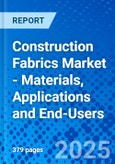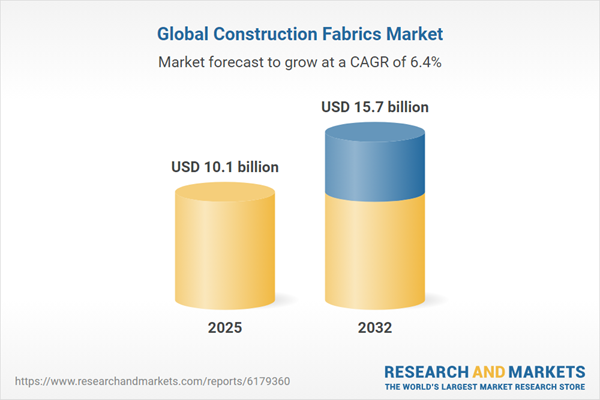Driven by rapid urbanization, infrastructure development, and the shift toward sustainable materials, the global construction fabrics market is projected to grow from US$10.1 billion in 2025 to US$15.7 billion by 2032, registering a CAGR of 6.4%. Expanding demand for large-span, lightweight membranes in stadiums, airports, and commercial complexes is accelerating adoption over traditional materials. ETFE- and PTFE-based translucent membranes, which enhance daylighting and energy efficiency, are particularly favored in tensile architecture. Advances in recycled polymers, nanocoatings, and digital fabrication technologies continue to strengthen the market outlook, though challenges remain around recyclability, cost, and compliance with fire and structural standards.
Construction Fabrics Regional Market Analysis
Accounting for an estimated 43% share in 2025 and projected to expand at a CAGR of 7.1% during 2025-2032, Asia-Pacific dominates the global Construction Fabrics market in both demand and growth. Rapid urbanization, large-scale infrastructure projects, and robust investments in airports, stadiums, highways, and public utilities are fueling extensive use of tensile structures, facades, and geotextiles across the region. Rising commercial and residential construction, driven by expanding middle-class incomes and real estate development, continues to boost adoption of lightweight roofing, cladding, and shading systems. The region benefits from abundant polymer availability (PVC, PTFE, ETFE) and strong local manufacturing capacity, which lower production costs and improve supply efficiency. Moreover, increasing use of advanced membranes and coatings tailored for tropical and high-radiation climates, coupled with growing emphasis on energy efficiency, recyclability, and aesthetic flexibility, ensures Asia-Pacific remains the fastest-growing hub for high-performance construction fabrics.Construction Fabrics Market Analysis by Material Type
Polyvinyl Chloride (PVC) dominates the Construction Fabrics market with an estimated 54% share in 2025, owing to its high tensile strength, UV and weather resistance, affordability, and design flexibility that make it ideal for tensile membranes, awnings, and roofing. PVC-coated fabrics balance performance and cost-effectiveness, offering long service life, easy maintenance, and customization in colors and translucency, while advances in recycling enhance their sustainability. In contrast, Ethylene Tetrafluoroethylene (ETFE) is projected to record the fastest growth at a CAGR of 8.4% during 2025-2032, driven by its superior light transmittance, energy efficiency, and recyclability. Lightweight, durable, and maintenance-free, ETFE enables transparent cushion facades and long-span structures favored in modern architecture, with innovations such as multilayer insulation systems, solar-control coatings, and photovoltaic integration expanding its applications across high-performance and sustainable building projects.Construction Fabrics Market Analysis by Fabric Type
Woven fabrics dominate the global Construction Fabrics market with an estimated 70% share in 2025, favored for their superior mechanical strength, dimensional stability, and proven performance in tensile structures, facades, canopies, and roofing. Their established supply base, ease of welding, and compatibility with coatings such as PVC, PVDF, PU, and PTFE make them the standard choice for long-lasting, load-bearing applications. Meanwhile, Nonwoven fabrics are poised for the fastest growth, registering a CAGR of 7.3% during 2025-2032, driven by their cost-efficiency, lightweight structure, and versatility in geotextiles, insulation, and temporary installations. Their rapid, low-cost production methods and ability to incorporate recycled fibers, filtration, and thermal or acoustic properties position nonwovens as a key alternative in modular, sustainable, and short-term construction uses.Construction Fabrics Market Analysis by Application
Tensile Architecture dominates the global Construction Fabrics market with an estimated 41% share in 2025, driven by its blend of functionality, aesthetics, and cost efficiency that enables expansive, column-free spaces for stadiums, airports, and commercial structures. Lightweight and durable, tensile membranes enhance energy efficiency, natural lighting, and sustainability, key priorities in modern urban infrastructure. Meanwhile, facade applications are expected to post the fastest growth at a CAGR of about 7% during 2025-2032, supported by rising demand for sustainable, visually distinctive exteriors with improved insulation and solar control. The ability of fabric facades to deliver design flexibility, ease of installation, and retrofit capability, especially in fast-urbanizing economies, positions them as the most dynamic and rapidly expanding segment in the Construction Fabrics market.Construction Fabrics Market Analysis by End-Use Sector
The Commercial sector leads the global Construction Fabrics market with an estimated 37.6% share in 2025, supported by widespread use in malls, airports, offices, hotels, and stadiums where functionality, design flexibility, and sustainability are key. Construction fabrics enable lightweight, energy-efficient, and visually striking structures through applications such as facades, canopies, and tensile roofing. Meanwhile, the Infrastructure sector is projected to grow the fastest, registering a CAGR of 7.3% during 2025-2032, as rising public and private investments drive demand for durable, cost-effective, and quick-to-install materials in airports, rail stations, bridges, and smart city projects. Their resilience, weather resistance, and sustainability credentials make construction fabrics integral to modern infrastructure development worldwide.Construction Fabrics Market Report Scope
This global report on Construction Fabrics analyzes the market based on Region, Material Type, Fabric Type, Application and End-Use Sector for the period 2022-2032 with projections from 2025 to 2032 in terms of value in US$. In addition to providing profiles of major companies operating in this space, the latest corporate and industrial developments have been covered to offer a clear panorama of how and where the market is progressing.Key Metrics
- Historical Period: 2022-2024
- Base Year: 2025
- Forecast Period: 2025-2032
- Units: Value market in US$
- Companies Mentioned: 20+
Construction Fabrics Market by Geographic Region
- North America (the United States, Canada and Mexico)
- Europe (France, Germany, Italy, Russia, Spain, the United Kingdom and Rest of Europe)
- Asia-Pacific (China, India, Japan, South Korea and Rest of Asia-Pacific)
- South America (Argentina, Brazil and Rest of South America)
- Middle East & Africa (Saudi Arabia, South Africa, Turkey, the UAE and Rest of Middle East & Africa)
Construction Fabrics Market by Material Type
- Ethylene Tetrafluoroethylene (ETFE)
- Polytetrafluoroethylene (PTFE)
- Polyvinyl Chloride (PVC)
- Other Material Types [Cotton, Nylon, Polyester, Polyethylene (PE), Polypropylene (PP) and Silicone Glass]
Construction Fabrics Market by Fabric Type
- Nonwoven Fabrics
- Woven Fabrics
- Other Fabric Types (Incl. Coated Fabrics, Composite Fabrics & Knitted Fabrics)
Construction Fabrics Market by Application
- Acoustics
- Awnings & Canopies
- Fa�ades
- Tensile Architecture
Construction Fabrics Market by End-Use Sector
- Commercial
- Industrial
- Infrastructure
- Residential
This product will be delivered within 2-4 business days.
Table of Contents
Companies Mentioned
- Ahlstrom-Munksjo OyJ
- Dongwon Industry Co
- DuPont de Nemours, Inc.
- Endutex Coated Technical Textiles SA
- EREZ Thermoplastic Products
- Freudenberg SE
- Hightex Maintenance GmbH
- Hiraoka & Co Ltd
- IASO
- Low & Bonar plc
- Milliken and Company
- Novum Membranes GmbH
- Saint-Gobain SA
- Sattler AG
- Seaman Corp
- Seele, Inc.
- Sefar AG
- SergeFerrari Group SA
- Sioen Industries NV
- Structurflex
- Taiyo Kogyo Corp
- Tensaform MembranE Sanayi Ticaret
- Verseidag-Indutex GmbH
Table Information
| Report Attribute | Details |
|---|---|
| No. of Pages | 379 |
| Published | October 2025 |
| Forecast Period | 2025 - 2032 |
| Estimated Market Value ( USD | $ 10.1 billion |
| Forecasted Market Value ( USD | $ 15.7 billion |
| Compound Annual Growth Rate | 6.4% |
| Regions Covered | Global |
| No. of Companies Mentioned | 23 |









